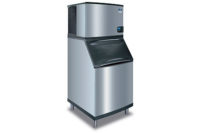COLORADO SPRINGS, Colo. — The road to natural refrigerants is a rocky one. There is much talk, but not a lot of action. However, this sector is certainly expanding. This “road” was a topic of discussion during the most recent International Institute of Ammonia Refrigeration (IIAR) Industrial Refrigeration Conference & Exposition in Colorado Springs, Colo.
Marc Chasserot, managing director for Shecco, a marketing firm that has websites for a number of natural refrigerants, told an audience of several hundred refrigeration engineers and contractors, “Yes, natural refrigerants are making inroads. But besides ammonia, it’s peanuts,” in terms of impact.
He said Europe “has the greatest immediate adoption potential for natural refrigerants while other regions show good potential.” He listed the naturals as ammonia (R-717), CO2 (R-744), air (R-729), propane (R-290), isobutene (R-600a), and water (R-718).
Currently the greatest attention is on CO2 being used in transcritical systems in some 1,600 supermarkets in Europe. Meanwhile, he said at the time of the conference there were 100 such supermarkets in Japan and 37 in North America — all in Canada. He noted an all-natural cascade system using ammonia and CO2 in a California supermarket with plans for transcritical CO2 stores in Illinois and Maine. He said the biggest success story for CO2 currently is its use in heat pumps in Japan where 3.5 million pumps are in use.
Regarding hydrocarbon refrigerants such as R-290 and R-600a, he said there are 400 million HC-based refrigerators in use worldwide, as well as 1.2 million ice cream freezers and 750,000 soft drink machines.
“So, yes, there is major potential,” he said. “And policies and regulations are favorable in the long term for natural refrigerants,” he said, referencing potential actions designed to control the use of F-gases such as HFCs. These include, he said, high levies on use of HFCs as is taking place in Australia; an HFC use ban in new installations in Switzerland; an HFC tax proposal in France; the possibility of European Union (EU) phase down and bans on HFCs once viable natural refrigerant alternatives are available; and global efforts to include HFCs in the Montreal Protocol to instigate a phase down of HFCs.
The EU effort is already being watered down, he said, in terms of the range of applications that might be subject to the phase down or phase out.
Commitment to Natural Refrigerants
During the same panel discussion, Bent Wiencke, manager for refrigeration engineering at Nestle USA, described how the company he works for has committed to using natural refrigerants and how it is striving to make such refrigerants work in a wide range of applications. He detailed how the company was using ammonia water chillers in positive temperature situations and CO2/ammonia cascade in negative temperature applications.
“We don’t have a global solution yet,” said Wiencke. “Solutions in Europe are not available in the U.S.”
But, picking up on Chasserot’s comment, he said, “The F-gas phase out is real and progressing in Europe and will be coming to North America, with more North American manufacturers providing cost-effective (natural refrigerant equipment) solutions.”
He also offered a pragmatic message for manufacturers in terms of environmental stewardship and potential regulations based on environmental concerns. “The larger the company, the larger the responsibility; the larger the company, the larger the risk of being targeted. Going natural reduces the size of the target. Natural refrigerants haven’t won yet, but they will in the future.”
Gaining Headway
Wayne Wehber, director at Vilter Mfg., noted developments regarding equipment using propane as a refrigerant. He said the Significant New Alternatives Policy (SNAP) program of the U.S. Environmental Protection Agency (EPA) accepts several HCs in some applications, which is an example of natural refrigerants gaining headway.
“This is something I was not sure I would ever see,” he admitted.
Wehber said broader use of HCs will require more equipment components designed for the refrigerants, more training, and better focus on dealing with site safety issues as HCs are A3 (flammable) refrigerants. But he did note that the ammonia sector has been successful in establishing guidelines that allow its applications to grow.
In the case of CO2, he cited a current lack of knowledge about the refrigerant as well as a need for more trained technicians, system service requirements, and guidelines.
“There is a high-design pressure, so we need system components for high pressure including valves, heat exchangers, and compressors,” Wehber said. “Overall, the industry is going to continue for the next few years to get standard components.”
Examining R-744
Also focusing on CO2’s potential in industrial refrigeration was Niels Vestergaard, director of market support for Danfoss A/S, who remarked that the most dominant refrigerant in industrial refrigeration is still ammonia. But, he acknowledged that CO2 is becoming increasingly important in this segment. For some applications and locations, safety requirements for large ammonia systems are rather demanding, he said. He added that an ammonia/CO2 cascade system is a unique way to combine the benefits of two natural refrigerants. Typically, the ammonia charge can be reduced to approximately one-tenth of a traditional ammonia system, and increase efficiency at low temperatures, compared to traditional ammonia systems.
He said the European industrial industry has more than 10 years of experience with CO2 applications, during which CO2 refrigeration equipment was continuously developed.
Major changes in product requirements included considerable increases in pressure, reduced leakage, and control valves operating precisely with high differential pressure. Also a system requirement like moisture contraction needs to be managed carefully, and training needs to be specific, said Vestergaard.
Like the other speakers, Vestergaard saw a wide range of natural refrigerant options. For industrial refrigeration, subcritical CO2 systems are dominant, but ammonia heat pumps for water heating with high temperatures are used, he said. For food-storage facilities, subcritical and transcritical CO2 are the dominant applications for natural refrigerants, and transcritical CO2 is used in transport refrigeration.
Publication date: 5/6/2013
Want more HVAC industry news and information? Join The NEWS on Facebook, Twitter, and LinkedIn today!












